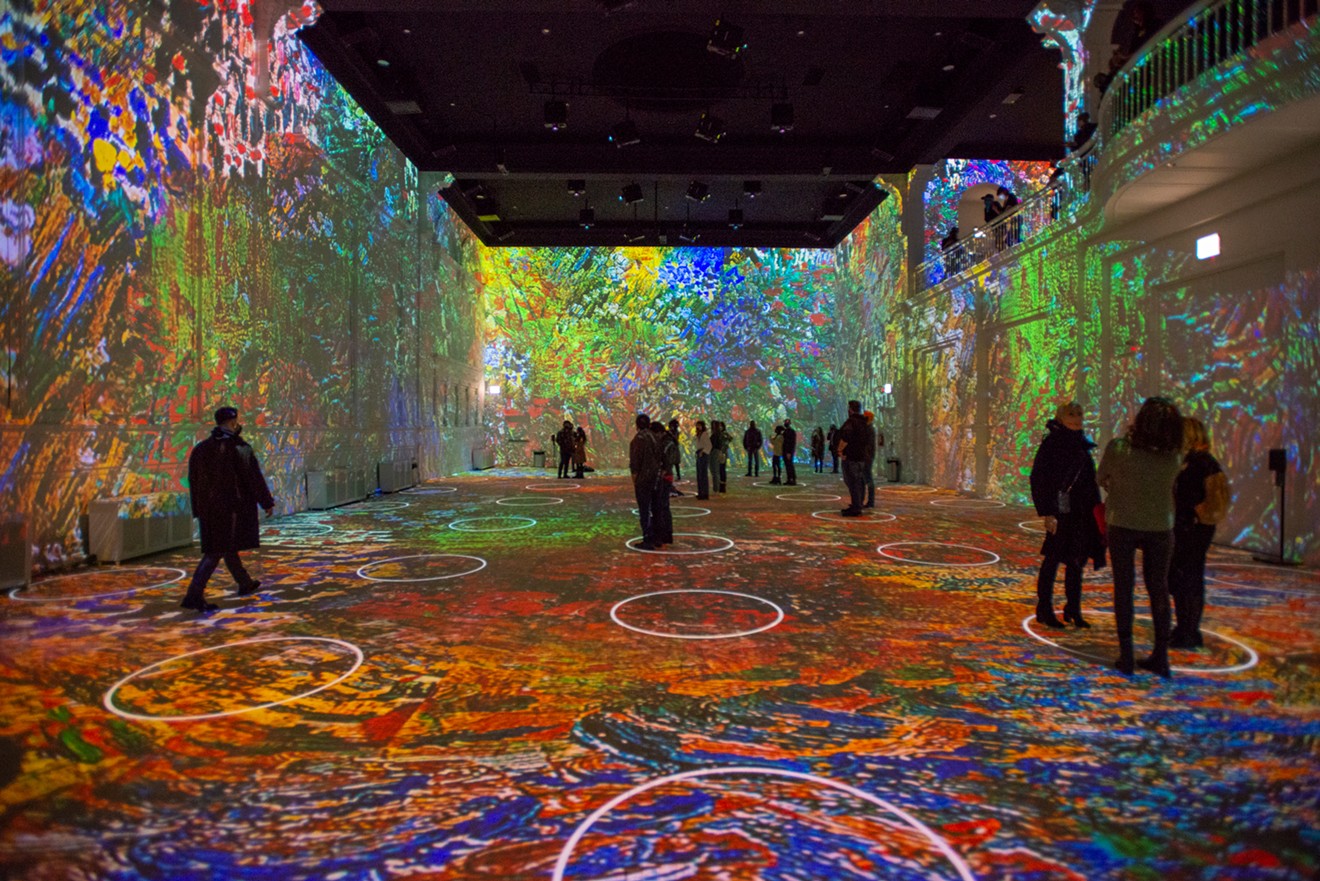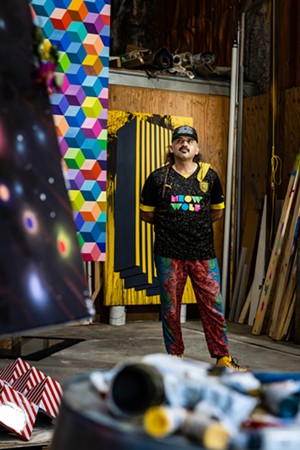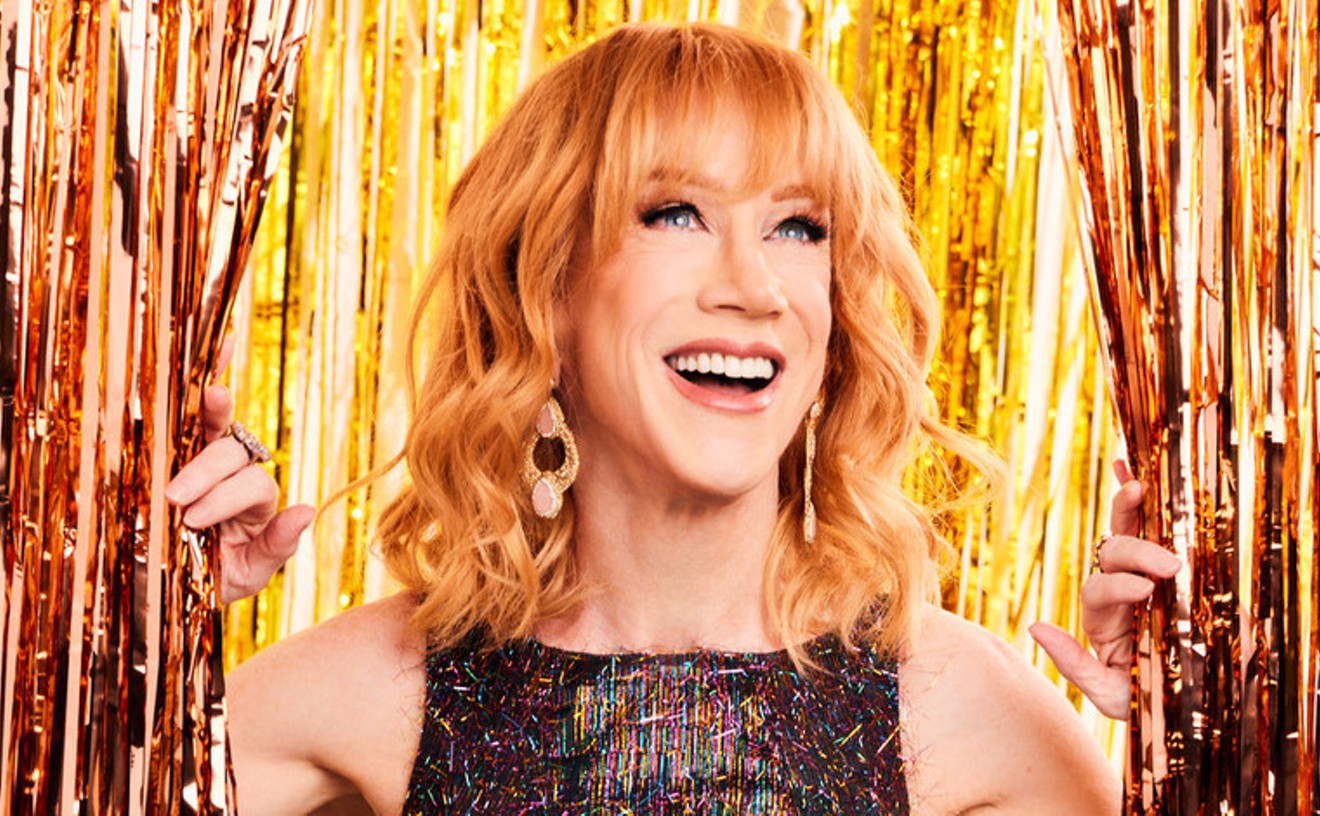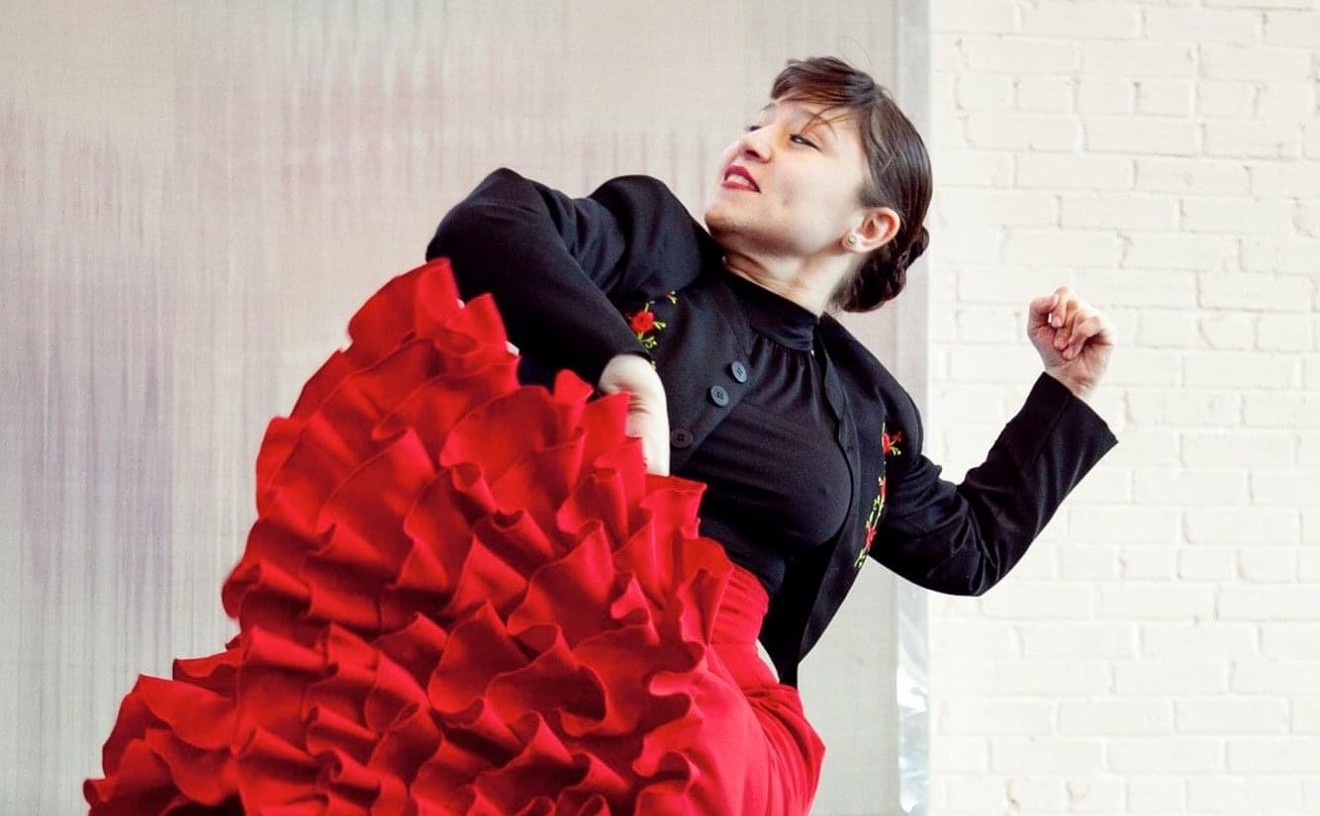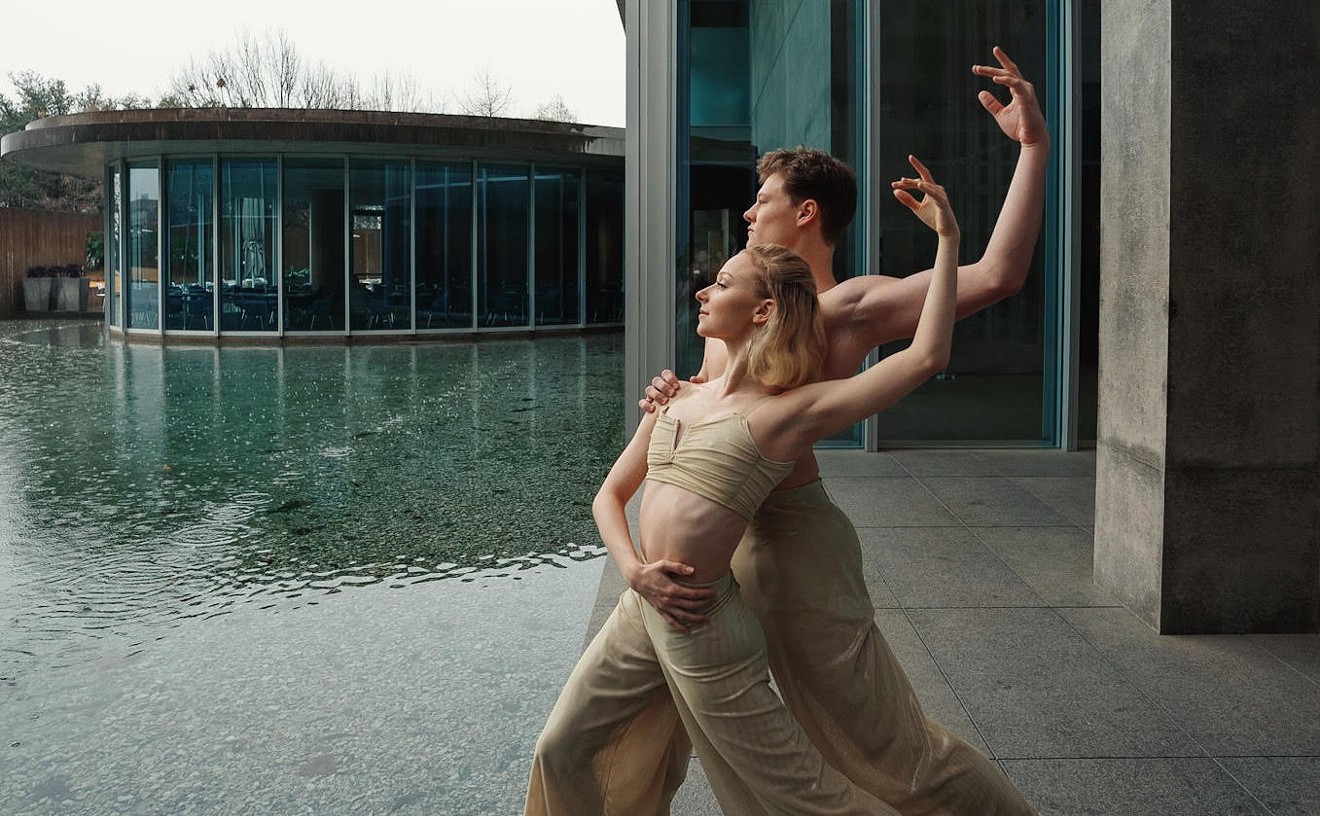While this idea was once possible only through the high-tech imagination of Disney fiction, it's become almost expected in the art world, and Dallas is keeping up with art lovers' taste for interactive, pop-up, immersive art.
Back in the olden days of the 20th century, if you wanted to engage with a work of art, you needed to enter a museum. Through hushed halls, viewers tried to get as close to a painting or sculpture as possible while trying to avoid being silenced or told to step back by a security guard.
But in 2022, the ways we consume art have changed drastically. At exhibitions such as Lighthouse Immersive's Immersive Van Gogh, giant sunflowers and po-faced peasants emerge and disappear, projected overhead and underfoot in a cavernous industrial space. In New Mexico's interactive mecca, Meow Wolf, the large-scale installations invite visitors to climb through walls, stroke tactile surfaces or create sounds. And in experimental pop-ups such as Dallas' Sweet Tooth Hotel, visitors use the surrounding works as colorful backdrops to garner all the likes on Instagram.
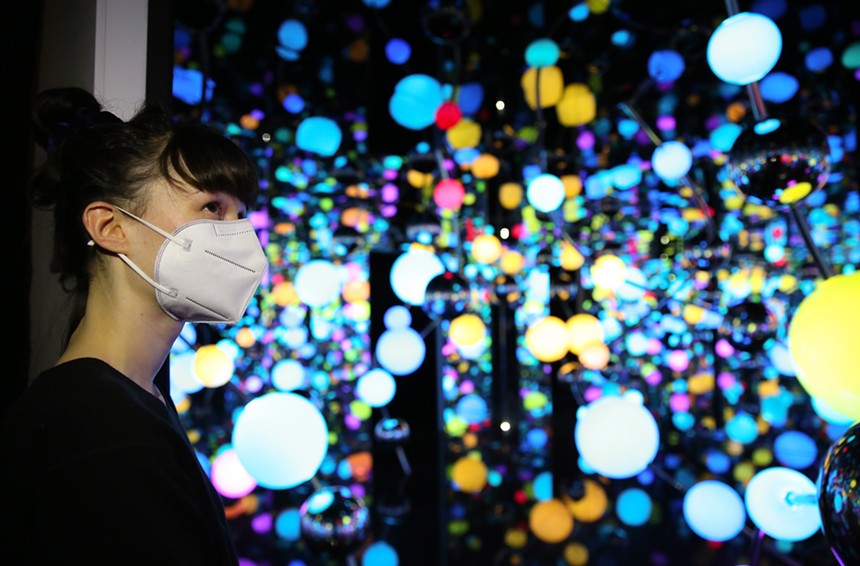
Infinity Mirrored Room: "The Infinite Lightof the Universe Illuminating the Quest forTruth” by Yayoi Kusama.
Adam Berry/Getty Images
"Kusama is the O.G. — the Meow Wolfs of the world would not exist if not for Kusama doing her crazy installations," says local artist Will Heron, who serves as the artist liaison for Meow Wolf's newest outpost, opening in a former Bed, Bath and Beyond at Grapevine Mills in 2023.
"Her work will still draw sold-out tickets because people want that experience," Heron says. "It's an influencer world we live in, so you see one person from your city who took this really cute picture [with a piece], then it's like, 'Oh my God, I need to go see that.'"
"Kusama was a huge influence to us," says Meow Wolf's founder and director, Vince Kadlubek, who began the collective with friends as a series of pop-ups and has since expanded to permanent sites in Santa Fe, Denver and Las Vegas.
"When we were starting, there was a Kusama show at The Broad [Museum] in Los Angeles, a James Turrell [exhibition] at LACMA [Los Angeles County Museum of Art], and [artist collective] teamLab at Pace Gallery, and all of these things were happening at the same time," Kadlubek says. "Any museum that has an exhibition of Kusama's work has record attendance because people want to experience an infinity mirror."
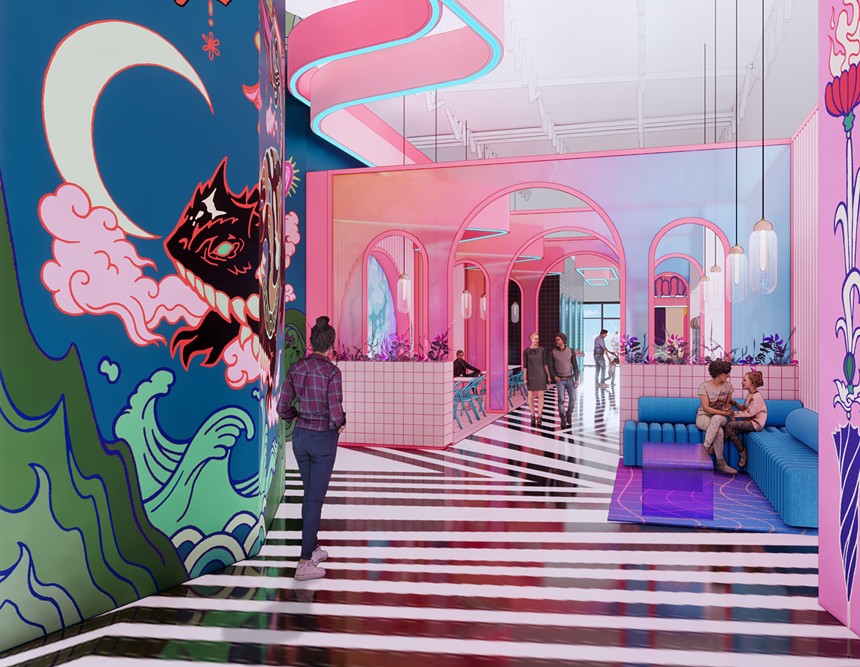
A lobby rendering of Meow Wolf’s Grapevine installation.
Mural design: Tsz Kam; Rendering: Gabriella Lovato Leger
Dallas Museum of Art senior curator Anna Katherine Brodbeck, who worked on the institution's Kusama blockbuster exhibition All the Eternal Love I Have for the Pumpkins in 2017, says the rise of immersive work started bubbling up as early as the mid-20th century. She cites phenomenological philosopher Maurice Merleau-Ponty's argument that perception's foundational role in the human experience is a precursor for the movement.
"[It has to do] with how we experience our own body in space with relationship to art objects and engaging all of the senses," Brodbeck says. "That's what influenced people like Kusama. I'm really interested in how this comes from an art history perspective. People are interested in taking their own image inside these works, but the desire for the artist to create them rose independently."
Brodbeck also feels the yearning for visibility in our current culture is another reason for the movement's success. As Kusama reclaimed her image through her work, so do modern creatives, such as queer artist Alex Da Corte, whose neon and video work "Rubber Pencil Devil" was the centerpiece of the DMA's For a Dreamer of Houses show last year.
In fact, a desire for visibility drove Meow Wolf's inception in the first place. In 2008, Kadlubek and friends were a group of Santa Fe talents who didn't fit the local gallery mode. To bridge the seemingly giant gap between the art market and artists, they created a series of pop-up spaces before launching the permanent "House of Eternal Return" with the financial help of Game of Thrones author George R. R. Martin in 2016.
"There was a real energy towards breaking the mold and showcasing art in a way that was less about selling paintings and more about experiencing directly the power of art and creativity," Kadlubek says of Meow Wolf's genesis. "Immersive started to become the medium we wanted to express ourselves with. It felt the most playful to us as artists. We were into showing our work to kids and tapping into that part of ourselves and getting excited."
Meow Wolf walked so the Insta "museum" could run. Major metropolitan areas can have as many as four or five of these experiences running at any given time. Dallas has its take on the phenomenon in the form of Jencey and Cole Keeton's Sweet Tooth Hotel.
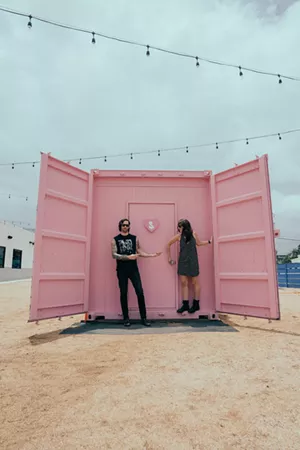
Cole Keeton (left) and Jencey Keeton opened Sweet Tooth Hotel in 2018 as a pop up in Victory Park.
Courtesy of Sweet Tooth Hotel
"In Dallas, that wasn't happening," she says. "I left Fossil and was working in real estate, which is one of the biggest investors in public art. I thought it would be really cool to bring an immersive experience here. I started talking with some of our friends who are artists and decided to just do one ourselves."
Initially opened in 2018 as a Victory Park pop-up, Sweet Tooth has since expanded to Watters Creek in Allen. Now the Keetons are gearing up to unveil the concept's most extensive permanent location in a 6,000-square-foot former gym at 1511 Elm St. Opening this fall, the space will offer a cocktail lounge sponsored by Adam Levine and Behati Prinsloo's Calirosa Tequila, a gift shop and multiple performance events.
And soon, others followed, though perhaps more in the "selfie factory" tradition of New York's Museum of Ice Cream: Rainbow Vomit, Museum of Memories, The Selfie Bar. The lines between art space and photo shoot set may have began to blur, but through its many iterations, Sweet Tooth continues to comprise installations by critically lauded artists.
An immersive concept may have done well for the Keetons, but it also benefited the city's emerging creative class. Artists who may not have been quite ready for the DMA were still primed to showcase their colorful vision in a single room. And millennials and Gen Z attendees responded enthusiastically.
"I was hoping 100 people would show up, and we'd break even, but Dallas was so starved for immersive art the whole thing sold out in one day," Keeton says.
Whether they're laden with a back story or just used as photo backdrops, Insta-worthy art spaces have a little competition in the form of immersive projection art. In 2018, renowned Italian creative director and film producer Massimiliano Siccardi launched Immersive Emotional Exhibitions with a show exploring Van Gogh's life through his work (conveniently avoiding the painter's pervasive mental illness). As shown on the first season of Emily in Paris, this experience was enough of a success in Europe that it was brought across the pond to multiple U.S. cities.
Dallas got its own Immersive Van Gogh in June 2021, followed a couple of months later by Van Gogh Exhibit: The Immersive Experience in Arlington, which offered virtual reality and three-dimensional tableaus of the painter's bedroom. Unsurprisingly, the competing exhibitions confused ticket buyers who weren't sure which experience they were meant to attend. In the same time span, the DMA brought Van Gogh's works to an exhibition called Van Gogh and the Olive Groves, featuring the artist's real-life "olive grove " painting series.
Located in downtown's Lighthouse Artspace (a former Masonic Lodge), Immersive Van Gogh emerged as the winner of the immersive Van Gogh exhibitions and is still running today, along with a rotating roster of other immersive shows from deceased artists, including Frida Kahlo and Monet and the Impressionists.
Comparing the immersive exhibitions to a showing of Van Gogh's in-the-flesh work is useless. One allowed viewers to see the brushstrokes of a genius close up from the distance in which he once stood, the other to immerse oneself into his works and colorful Pointilist ecosphere. One shows the finished, historic product; the other emulates, in a sense, his fantastical inner world: the zooming, moving, dancing images come to life.
Rather than taking away visitors from the Olive Groves exhibition, it's possible the immersive Van Gogh exhibitions introduced the works of the painter to some who might never have ventured to the museum to see his real works displayed. They are entirely separate experiences; it's like comparing an anime movie to the classic book on which its based. It's apples and oranges — or rather, Magritte's apples and Kusama's pumpkins.
Next up at the space will be exhibitions devoted to King Tut and The Nutcracker, proving that the experience of being immersed in something — painting, classical dance or history — is just as important as the subject matter.
One thing you won't necessarily get from immersive experiences is historical accuracy. Shows such as Immersive Van Gogh don't tell an artist's story in any linear fashion. Works from different periods are chopped up and overlaid, and images drift in and out of the screen to a mellow soundtrack ranging from Radiohead to Edith Piaf. The intent is not to walk away with Art History 101 knowledge but to digest an artist's oeuvre as a dose of mental and aural Xanax.
"We don't want to be the curator of historical accuracy. We want to present a beautiful thing that comes in all forms … in a place where people can move around and be enveloped by sounds and visuals," says Leisha Bereson, vice president of marketing at Impact Museums, which co-produced Immersive Van Gogh alongside Lighthouse Immersive.
"There's a lot going on in the political and emotional landscape, and people are exhausted and looking for an escape moment."
Yet viewing art merely as a moment of escapism has never been what drove traditional curation. Museums and art spaces aren't anti-immersion necessarily, but it is surprising to discover that many curators have never darkened the door of an immersive exhibition or Instagram-friendly space. For them, having an exhibition or specific piece reach critical mass in the virtual world is a byproduct of their work, not the end goal itself.
"I don't think art museums worth their salt make decisions with Instagram in mind," says Lucia Simek, director of external affairs at the Dallas Contemporary. "You operate with an art-first attitude, but that doesn't mean when people enter a museum, they don't have an opportunity to make it an Insta moment. We're about to mount [muralist and graffiti artist] Shepard Fairey, and there are two murals on the back wall which have been a part of his practice since way before [immersive art] has been a thing, but of course, a visitor will turn it into an Insta moment. It ultimately benefits the museum because you get attention without having to seek it."
Just as useless is expecting galleries will ever go back to a traditional "look, don't touch" model and ignore the demand for art made for a screen-dependent generation. While the world changes, the art world will naturally follow, as it always has.
Despite its mega-success, Meow Wolf's Kadublek says the art space has endured its share of criticism.
"It's funny because we will hear that Meow Wolf isn't real art, and it just makes us laugh," Kadublek says. "The bigger, more interesting conversation is who gets to define what art is. I think it's a generational effect: The art world has evolved to be more about the market of art, which means it becomes a barrier of entry. It's also moved into a highly educated realm, which is also a limiting factor over time when the reality is that creative expression is something everybody has. Everyone was born an artist."
In other words, if you're not into immersive art, just don't, erm, Gogh. And, whether they're willing to admit it or not, traditional institutions can't help but nod to immersive trends now and again. Aside from the Contemporary's Shepard Fairey: Backward Forward opening on Sept. 25, the Dallas Museum of Art has launched Movement: The Legacy of Kineticism, which features such pieces as Valeska Soares' "Vaga Lume." Visitors can explore the work by switching overhead light fixtures on and off to create a deeply personal experience.

"Vaga Lume," an interactive light piece by artist Valeska Soares, is part of the special exhibition Movement: The Legacy of Kineticism. The show premiered at the Dallas Museum of Art on Sept. 18.
Eduardo Ortega
Says Modern curator Alison Hearst, "Bender's piece called 'Total Recall' was a very prescient work. She totally saw this 24/7 news cycle coming our way in the '80s. She called it electronic theater, and it's completely immersive. Of course, it was created before the likes of social media, but it's a piece I think people are going to stay in the space for a long time and take it all in."
However you prefer to consume art, both traditional curators and the founders of immersive experiences have the same goal — to awaken the viewer's senses and get them interested and engaged in art.
"If [immersive art] is the gateway drug, then I think that's amazing," says Brodbeck. "What differentiates what we do from the Immersive Van Goghs of the world is we believe in the power of the encounter. All you see with an immersive exhibit is an image of the artwork produced at scale. You lose the texture or the aura of being around the original artwork. I understand that historically museums have been intimidating. Having exhibits you can interact with is a gateway for someone to go up to our European galleries and see an old master on the wall."
Ostensibly in the future, the life cycle of an artist could move from interactive spaces like Sweet Tooth to the bigger-budget Meow Wolf to a legitimate place in a respected gallery or institution. Then, who knows? If immersive art builds enough of a legacy, the next generation may experience a future artistic legend's work on view eternally in the metaverse.
Local artist Ricardo Paniagua, who will have a room at the new Meow Wolf, says, "I want to have an immersive Ricardo while I'm alive! I do think it sets art free and makes it less exclusive. Conceptual art is gatekeep-y. We're like pack animals, so I think the digitization of art is a good thing — it enhances people's quality of life more than it does harm."
Whatever an art lover's reason for choosing their own adventure, there's no denying the eye has to travel, and it always will.
"I think that people go to see art for all sorts of different experiences," says Brodbeck. "Some for quiet contemplation, and some are into an immersive experience. And we could all use a little magic, especially coming off a pandemic. We're all looking for those moments of sociability and magic — that's a basic human need."

